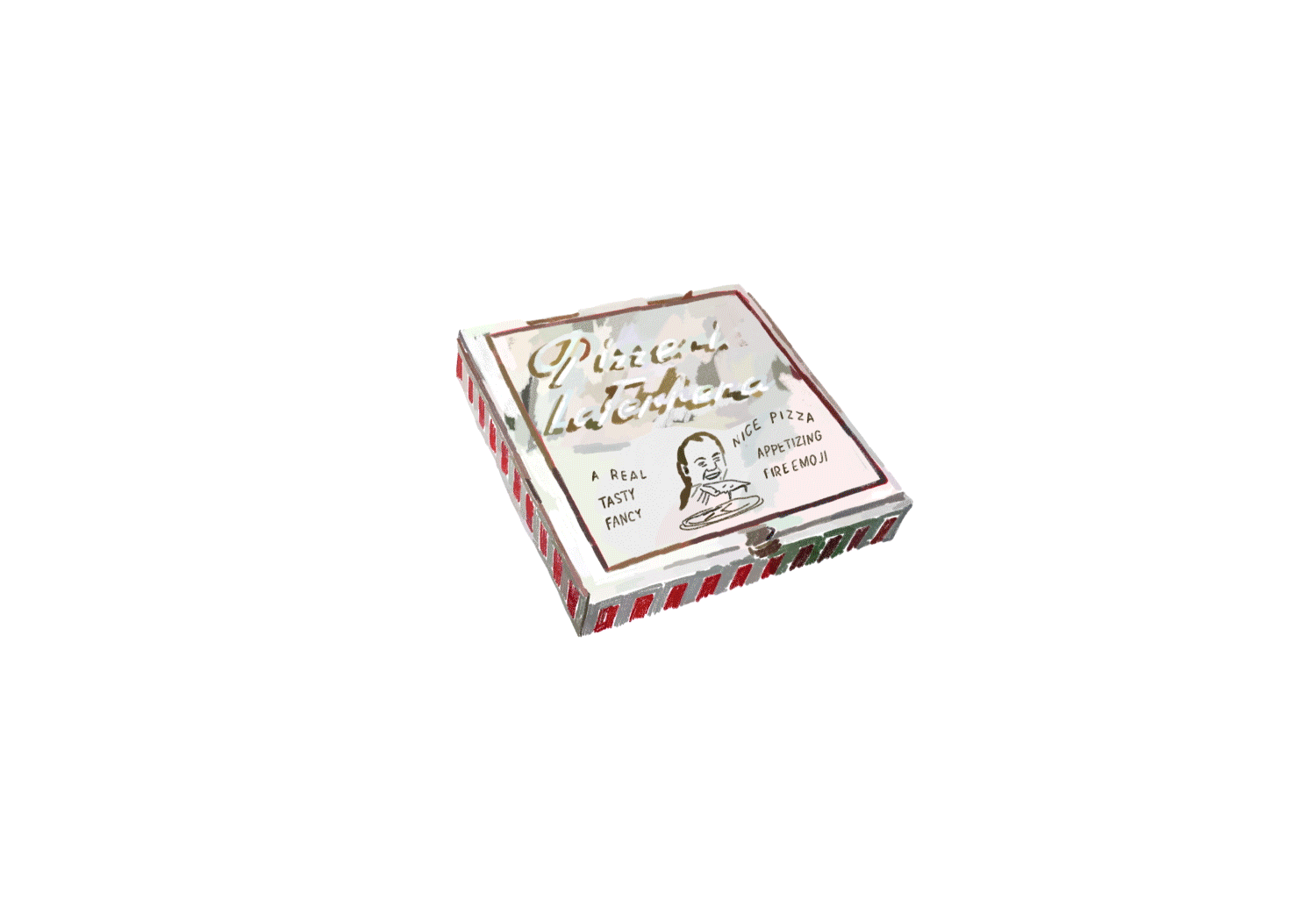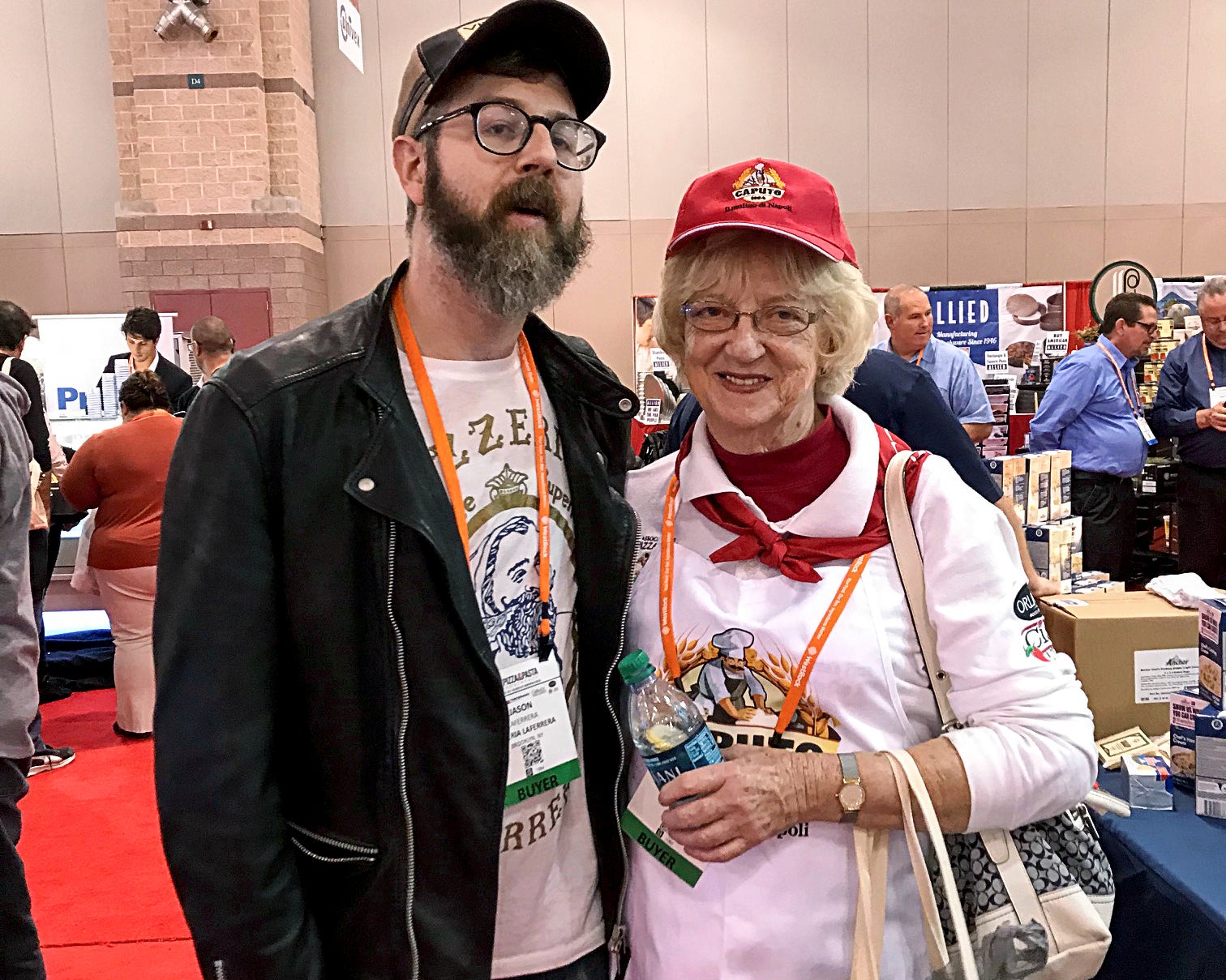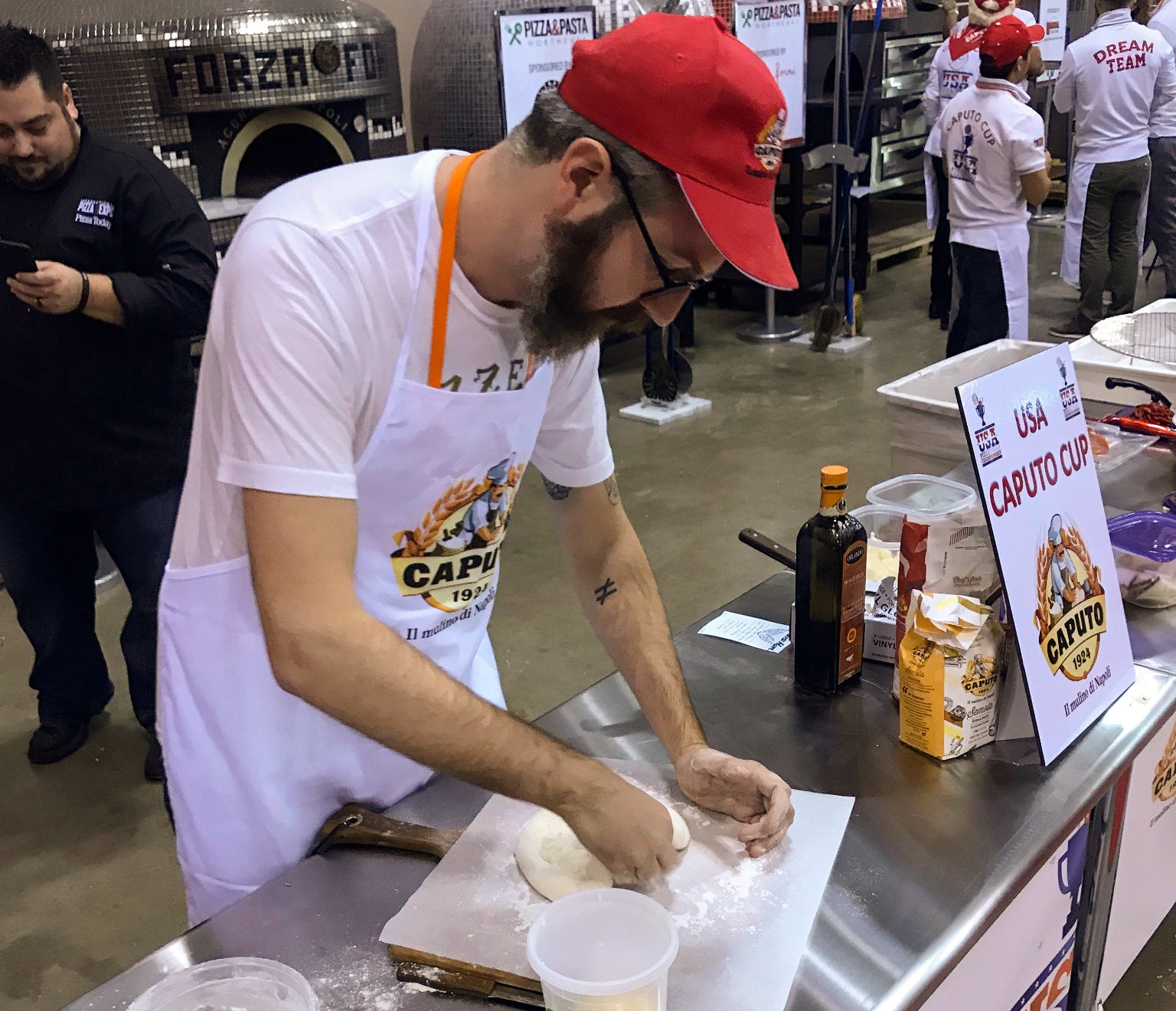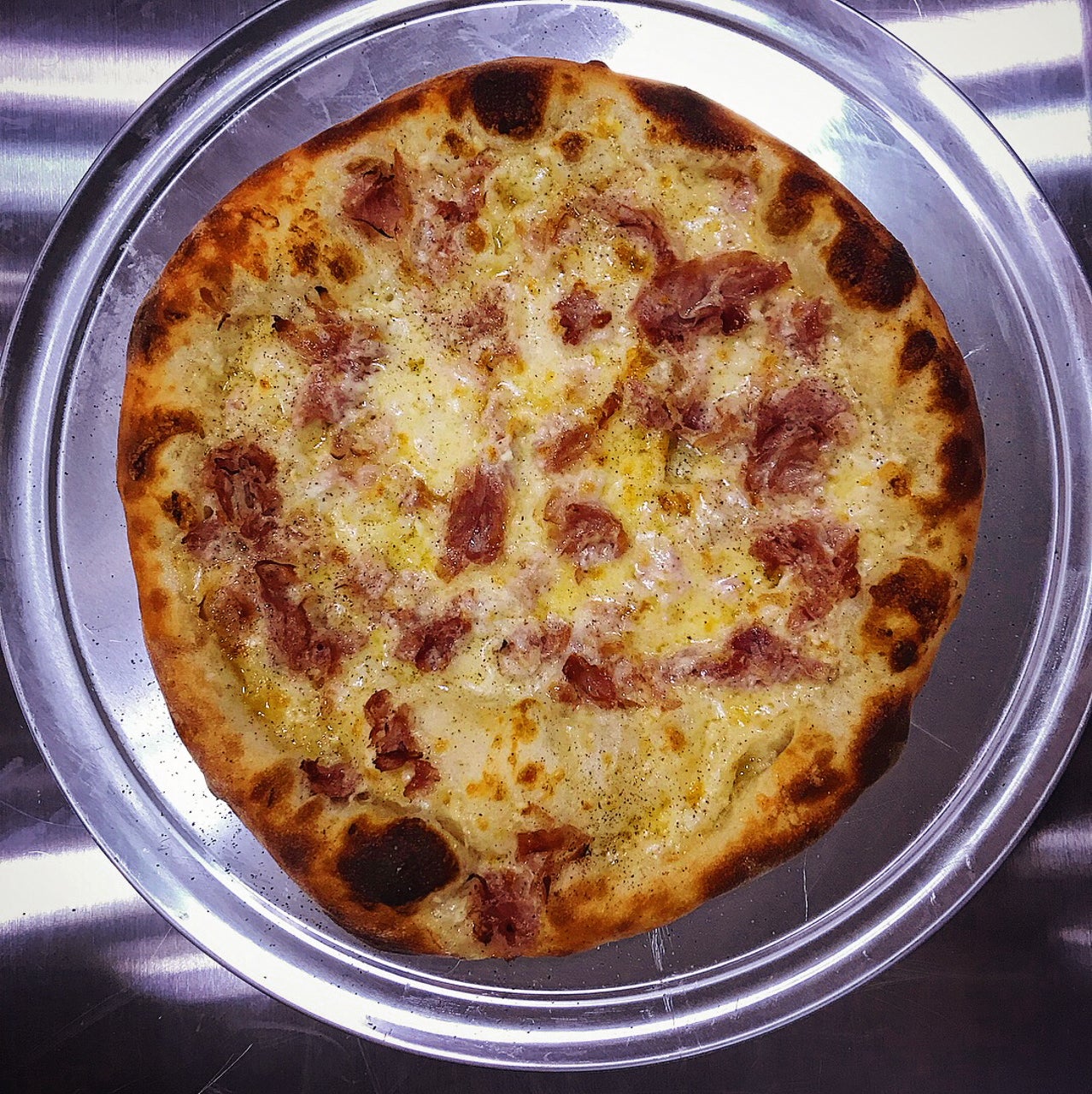
An aspiring pizzaiolo goes for gold at the Caputo Cup.
I woke up in Atlantic City’s Caesar’s Palace, a little bloodshot from the previous night’s debauchery at the Rainforest Cafe after Molly’s big $40 win at the Britney Spears video slot machine. Okay, it wasn’t a full-on AC bender, but our room was still a mess. Instead of the remnants of a night of hard partying, the hotel room was littered with pizza-making equipment placed on every available surface. The two pizza peels propped against the desk weren’t the worst of the clutter, but the bag of flour that had spilled onto the carpet made it look like we raged harder than we actually did. The night before we’d crammed three balls of 72-hour fermented dough, some earthy alpine cheeses, and a bundle of ham from the Meat Hook into the mini fridge alongside a tub of béchamel. Oh, the aroma. Those gaudy drapes would never smell the same.
As Molly looked up directions on her phone, I carried the cooler to the ice machine down the hall, where an old man wearing oversize khakis and a Navy hat gave me a puzzled look. “Going fishing today, son?”
“No,” I said. “I’m going to make pizza.”
My relationship with Molly is mostly based around pizza—our initial online flirtations involved sending pizza memes back and forth. We had our first date at Paulie Gee’s in Brooklyn and actually got engaged there, too. We spent our honeymoon in Naples, where, sitting in the alley behind Gino Sorbillo’s (who waits 90 minutes to eat street food?), folding our pizza on top of itself (the infamous Neapolitan quadfold), we decided that we needed to learn to make it ourselves. Really great pizza. In our home kitchen.
Once back in New York, we used the free time that was once allotted to wedding planning to Malcolm Gladwell ourselves 10,000 hours of pizza mastery. We bought books, watched YouTube videos, and scoured pizzamaking.com (which I quickly learned was the definitive forum for pizza aficionados). Our pizzas started off as amorphous, pale, flat blobs that would cling to the peel and set off the smoke alarm. But through trial and error they graduated to something halfway decent. Eventually we were sculpting circles (well, close to circles) with the mythic leopard-spotted char on the “undercarriage” (pizza-making parlance for the bottom of the pie) and a nice open crumb on the cornicione. We borrowed flavor combinations from sandwiches and pastas we liked and figured out not to go overboard with toppings that created a soupy mess.
The pizza output was too much for just the two of us, so we began inviting friends over to share and, in the process, gather feedback about how we could improve. Nothing legitimizes an idea like a T-shirt, so in true indie-rock fashion, Molly designed a logo for our infantile endeavor, and Pizzeria LaFerrera was born.
For the past two years we’ve been operating Pizzeria LaFerrera as a supper club out of our Brooklyn apartment. Every Sunday, we invite over four to six friends (or sometimes strangers from the Internet) and feed them half a dozen pizzas we’ve baked in our standard-issue rental apartment oven. With each pie, we try to one-up each other with pizza puns (Torta Recall is the current favorite) and close out the meal with amaro and a list of science fiction movies to screen.
We do our best to create a salon atmosphere, playing matchmaker to like-minded individuals, inviting a bunch of software developers (my friends), designers (Molly’s friends), artists, and musicians who we think will get along. More often than not, these strangers end up becoming friends (often due to their mutual love of Pavement, Guided by Voices, and other mid-’90s alt-rock). While Pizzeria LaFerrera is tiny and invite-only, word has trickled out. We’ve been asked to cater a couple conferences and even hosted a pop-up or two at friends’ restaurants.

In July, I learned that Pizza Today, the largest of the pizza-industry trade magazines, was going to augment Pizza Expo, its huge annual Las Vegas convention, with an East Coast event. The 2017 North East Pizza and Pasta Expo was going to be held in the Atlantic City Convention Center, much more convenient to reach from Brooklyn. Of course Molly and I planned on attending. But then, when I was filling out our online registration, a shiny check box asking, “Would you like to compete in this year’s Caputo Cup?” caught my eye.
I knew that the Caputo Cup—a high-stakes pizza-making competition—was the highlight of the Vegas convention. Its winners can lay claim to the preeminent award in pizza-making. Previous cup winners have usually been from famous pizzerias, spots that have been around for eons and show up on top ten lists for best pizza in the country, places like Williamsburg Pizza in Brooklyn, Tony’s Pizza Napoletana in San Francisco, and Rossopomodoro in Chicago. These winning pizzaiolos show up on Good Morning America and grace the cover of Pizza Today. It’s a pretty big deal.
For the competition in November, there were four categories to choose from: Neapolitan, NY Traditional, Non Traditional, and Gluten Free. We had just spent the past year testing out various fermentation times and dough hydrations, so Gluten Free was out of the question. The Neapolitan and NY Traditional divisions had insanely tight requirements about ingredients (and their origins), pie sizes, and timing that were just downright terrifying. There were no team entries, and Molly was too nervous to compete solo, so I selected Non Traditional and clicked “submit.” And then I wondered what I had gotten myself into.
Was this going to be like some TV competition show like Top Chef or Chopped? Would there be an announcer detailing my every move? Dramatic cut-away music? Totally clueless about what to expect, I sent a direct message on Instagram to Anthony Falco, the former Pizza Czar of Roberta’s, a man I had never met in real life. “Anthony,” I said. “I’ll buy you a drink if you’ll explain what is about to happen to me.”
We met me at a bar in Williamsburg, chatting about some people we knew in common so I didn’t seem like some insane pizza fanboy. Anthony ordered a Tecate-and-tequila-shot combo (he is from Austin, after all), so I got the same. He explained to me that the Caputo Cup wasn’t some hypercompetitive battle royale–style tournament, but more like a friendly game between fun-loving pizzaiolos who usually only get to see each other once a year. Judging by how nice Anthony was to come give advice to some Instagram fan, I tended to believe him. His biggest takeaway was to be prepared for things to go wrong and have as much prepared ahead of time as possible. Anthony made it clear: Just go have fun, meet some other people who love pizza as much as we do, and don’t sweat the cup.

The author with Norma Knepp, winner of the 2015 Caputo Cup.
We lugged the cooler, full of ice and expensive cheese, the three-quarters of a mile from the hotel to the convention center. When we walked inside, the space was cavernous, bigger than an airline hangar. There were even businessmen in suits rolling suitcases (mostly full of tote bags and other swag) to the registration desk, eager to drum up some new leads for their artisanal product line. The expo wasn’t officially open yet, so it was just vendors setting up booths on the floor. Dozens of people were wearing matching neon orange polos for some tomato company I had never heard of. Others were assembling a balloon arch that looked like a bar mitzvah decoration. It was like showing up to a party 15 minutes early when the host is expecting everybody to be an hour late. It was near chaos.
Molly and I joined the almost 150 pizzaiolos gathered at the competition area for a breakdown of the rules. Despite making pizza regularly for the past two years, we felt incredibly out of place within the group. The pros were wearing shirts with pizzerias’ names embroidered on them; some of them were even wearing chef’s whites. People were hugging and posing for pictures. We didn’t know anyone here.
While everyone was milling about, we sat next to Norma Knepp, who runs a stall in the Roots Country Market in Lancaster, Pennsylvania. Norma won the Caputo Cup in 2015 and is a bit of a celebrity in the pizza-making community, a 70-year-old gruff grandmother who was recently featured on Vice’s Pizza Show. Some of the other competitors were pizza shop owner-operators; others were chefs who’d been flown here on their boss’s dime to hopefully take home the trophy that would propel their pizza joint to fame. These were some of the nation’s prominent pizza makers, representatives from pizzerias that are institutions and crank out hundreds of pies a night. Scott Wiener from Scott’s Pizza Tours was chatting with Anthony Scardino from Chicago’s Professor Pizza, and I spotted Frank Pinello of Best Pizza and Mark Iacono from Lucali over at the judges’ area. They were all heavyweights, and Molly and I were a designer and a programmer and make six pizzas a week. I was beginning to wonder if I’d made a serious mistake.
Once the convention officially opened, the competition area was full of frantic energy, everyone scrambling about in the makeshift kitchen prepping last-minute sauce and toppings. Molly and I had followed Anthony’s advice and prepped everything back at home—and in our hotel room the night before—so we found a nook in the communal fridge to drop our supplies and wandered around the expo floor. The convention was a cross between Willy Wonka’s Chocolate Factory and E3. There were booth babes and conveyor-oven demos and plenty of free pizza samples. Purveyors would come up and ask Molly and me about our buffalo wing sauce provider, or how old our point of sale system was. As off-putting as the sales tactics were, it made total sense. The expo was aimed at the franchise owner or the local slice-joint proprietor, not pizza enthusiasts like us.
The competition area felt less hectic than over by the expo booths, and definitely less like a sales floor. The area designated for spectators was surprisingly full, with rows of folding chairs facing the line of prep tables and ovens. It didn’t help my nerves that the entire event was set up like some spectator sport. Some of the ovens were wood fired and imported from Italy, while others were the deck ovens by brands I’d seen in neighborhood spots in Brooklyn. (You start to notice these things your first year into pizza-making.)
Molly and I had never used either of these kinds of ovens—we’re limited to the wonderful General Electric furnished by our Polish landlord—so this was all new and intimidating. Maybe it was the 20 ounces of iced coffee that I had chugged to compensate for the morning’s hangover, or maybe it was just increasing anxiety as my allotted bake time was approaching, but I found myself starting to tremble. We sat down in the folding chairs and watched another competitor have his shot, quickly stretching the dough and gracefully launching his pizza into the fire with the confidence of having done this a hundred times every night. Despite Molly’s reassurances, this was not helping my current mood.
“Jason LaFerrera,” the head volunteer proclaimed with less mispronunciation than I’m used to. I looked around, confused. My allotted time wasn’t for another hour; my dough was still proofing. “We’re running ahead of schedule,” the volunteer said. “Don’t worry, you’ve got this.”

Molly and I ran to kitchen and gathered our supplies. While everyone else had arrived with dough boxes and Cambros, our gear was stuffed in a grocery bag and recycled Chinese takeout containers. One of the organizers started the timer, and I opened my dough container. I poked the ball with my finger and it didn’t spring back quite as fast as I wanted it to. I started to stretch dough, but it was way too cold and refused to cooperate. I knew that I needed about a six-minute bake time in the 600-degree oven, so I made sure to reserve at least that much time while trying to work my dough into a 14-inch circle.
Molly was standing on the opposite side of the aluminum prep table snapping pictures while I kept asking if she thought the disc was finally big enough. With an eye on the clock, I began ladling on the béchamel, and a volunteer remarked how great it smelled. I sprinkled on the Gruyère and started running the pizza toward the oven when I heard Molly yell, “The ham!” In my bewildered state I had completely forgotten the titular ingredient of my pizza, christened Trans Ham after my favorite band. I rushed back to apply a layer of our neighborhood butcher shop’s salty, smoky pork, then flung the raw pizza into the deck oven furthest from my station.
Then there was nothing to do but wait.
I paced back and forth while the timer counted down.
“How’s it looking?” Molly asked. The only reply I could muster was a shrug. After two minutes I rotated the pie 90 degrees and checked the undercarriage. It was still entirely too pale and undercooked. I watched the kitchen timer tick down the seconds. Finally, with only 30 seconds left, the pizza had to come out, done or not. The crust wasn’t as dark as I wanted it to be, but this wasn’t the worst-looking pizza I had ever made. One of the volunteers scrambled to find a clean pan while the pizza teetered at the edge of my peel. Grinding the pepper mill faster than any human has ever cracked pepper, I glanced at the timer. Three seconds left. I fumbled toward my jeans pocket under the chef’s apron trying to get my phone out. “Relax,” one of the staff members said. “Your pizza is done and the timer is done. Take as many pictures as you want.” And so we did. Someone even offered to snap a picture of Molly and me with the pizza. And with that, my pizza was carted over to the curtained-off judges’ area to await its fate.
The winners weren’t announced until the next day, but neither Molly nor I could afford to take another day off of work, so we drove back to Brooklyn still abuzz with adrenaline from competing in our veins. During the car ride back, Molly told me about some of the other competitors’ pizzas she’d seen while I was an oblivious bundle of nerves. “Yours looked really good!” she said. “Some of the others looked too wacky, and one guy didn’t even finish in time!” Maybe we actually had a shot at winning?

The Trans Ham.
The next day we fervently refreshed Instagram and Twitter at 4 p.m., the time the winners were supposed to be announced, but there was no new information. I kept scrolling and clicking, hoping to see a list of the rankings, any photo I could pull into Photoshop to zoom and enhance, but there wasn’t a single shot with the scores even remotely visible. I stalked the Atlantic City Convention Center location tag on Instagram until at last there it was, the head of Caputo Flour handing out oversize checks to the winners. Which meant, I realized, that we didn’t win.
Walking home from work that day, I thought it over. The mere act of entering the competition felt like a validation of our pizza-making quest. I had competed against 40 entrants. The goal was never to win the Caputo Cup. Of course we weren’t going to win. We just wanted to learn how to make good pizza and see our friends more regularly.
Entering the competition had just been a fun thing to try after obsessing over our hobby for the past two years, a chance to see how we compare to the professionals who do this every day. I had held my own and baked a proper-looking pie that I knew tasted great even without taking a bite. It was a representation of the two years of knowledge we had gained. My sad, slouched posture began to perk up at this realization, and I checked my phone while waiting to cross the street at a red light. There it was at the top of my feed: Non Traditional – 3rd Place: Pizzeria LaFerrera. 